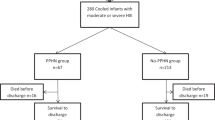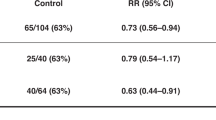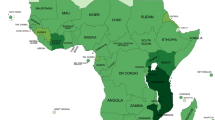Abstract
Background
Physical separation contributes to parental trauma and poor bonding in the context of therapeutic hypothermia (TH) for hypoxic-ischemic encephalopathy (HIE). Parental holding (PH) may improve parents’ experience. We aim to determine the physiological and behavioral stability of the newborn held by the parents during TH.
Methods
Observational, prospective, single-center study which included 30 newborns with mean gestational age of 39 (1.8) weeks and mean birth weight 3165 (508) g, with HIE treated by TH, whom parents wanted to hold. All infants were mechanically ventilated and received sedation-analgesia. Main outcome was change in body temperature (> 34°C or < 33 °C) during PH. Secondary outcomes were change in vital signs and behavior (comfort/pain scores) during PH. Parental and nurses’ opinions were assessed by a self-reporting questionnaire with a 10-point Likert scale.
Results
We found no significant changes in temperature, other vital signs or in infants’ COMFORT-B score during parental holding. Responses to self-reporting questionnaires completed by parents and nurses showed a high level of overall effectiveness and satisfaction with PH.
Conclusion
Parents holding newborns undergoing therapeutic hypothermia for hypoxic-ischemic encephalopathy was safe for the newborn without causing discomfort. It was also beneficial for the parents and supported by the healthcare team.
Impact
-
Parents holding newborns undergoing therapeutic hypothermia for Hypoxic Ischemic Encephalopathy was feasible without causing discomfort. It was also beneficial for the parents and supported by the healthcare team.
-
Infants’ temperature or other vital signs did not change during parental holding, which was found very satisfactory by parents and healthcare givers, showing that parental holding is feasible.
-
This study promotes further dissemination of parental holding, which may limit the detrimental effect of physical separation for parents of newborns undergoing therapeutic hypothermia.
This is a preview of subscription content, access via your institution
Access options
Subscribe to this journal
Receive 14 print issues and online access
$259.00 per year
only $18.50 per issue
Buy this article
- Purchase on SpringerLink
- Instant access to full article PDF
Prices may be subject to local taxes which are calculated during checkout


Similar content being viewed by others
References
Thornberg, E., Thiringer, K., Odeback, A. & Milsom, I. Birth asphyxia: incidence, clinical course and outcome in a Swedish population. Acta Paediatr. 84, 927–932 (1995).
Pierrat, V. et al. Prevalence, causes, and outcome at 2 years of age of newborn encephalopathy: population based study. Arch. Dis. Child Fetal Neonatal Ed. 90, F257–F261 (2005).
Shipley, L., Gale, C. & Sharkey, D. Trends in the incidence and management of hypoxic-ischaemic encephalopathy in the therapeutic hypothermia era: a national population study. Arch. Dis. Child Fetal Neonatal Ed. 106, 529–534 (2021).
Kurinczuk, J. J., White-Koning, M. & Badawi, N. Epidemiology of neonatal encephalopathy and hypoxic-ischaemic encephalopathy. Early Hum. Dev. 86, 329–338 (2010).
van Schie, P. E. M. et al. Long-term motor and behavioral outcome after perinatal hypoxic-ischemic encephalopathy. Eur. J. Paediatr. Neurol. 19, 354–359 (2015).
Badawi, N. et al. Autism following a history of newborn encephalopathy: more than a coincidence? Dev. Med Child Neurol. 48, 85–89 (2006).
Gluckman, P. D. et al. Selective head cooling with mild systemic hypothermia after neonatal encephalopathy: multicentre randomised trial. Lancet 365, 663–670 (2005).
Shankaran, S. et al. Whole-body hypothermia for neonates with hypoxic-ischemic encephalopathy. N. Engl. J. Med 353, 1574–1584 (2005).
Azzopardi, D. V. et al. Moderate hypothermia to treat perinatal asphyxial encephalopathy. N. Engl. J. Med 361, 1349–1358 (2009).
Jacobs, S. E. et al. Whole-body hypothermia for term and near-term newborns with hypoxic-ischemic encephalopathy: a randomized controlled trial. Arch. Pediatr. Adolesc. Med 165, 692–700 (2011).
Jacobs, S. E. et al. Cooling for newborns with hypoxic ischaemic encephalopathy. Cochrane Database Syst Rev CD003311 https://doi.org/10.1002/14651858.CD003311.pub3 (2013).
Craig, A. K., James, C., Bainter, J., Evans, S. & Gerwin, R. Parental perceptions of neonatal therapeutic hypothermia; emotional and healing experiences. J. Matern Fetal Neonatal Med 33, 2889–2896 (2020).
Bäcke, P., Hjelte, B., Hellström Westas, L., Ågren, J. & Thernström Blomqvist, Y. When all I wanted was to hold my baby-the experiences of parents of infants who received therapeutic hypothermia. Acta Paediatr. 110, 480–486 (2021).
Heringhaus, A., Blom, M. D. & Wigert, H. Becoming a parent to a child with birth asphyxia-From a traumatic delivery to living with the experience at home. Int J. Qual. Stud. Health Well-being 8, 1–13 (2013).
Horsch, A. et al. Impact of perinatal asphyxia on parental mental health and bonding with the infant: a questionnaire survey of Swiss parents. BMJ Paediatr. Open 1, e000059 (2017).
Laudi, A. & Peeples, E. The relationship between neonatal encephalopathy and maternal postpartum depression. J. Matern Fetal Neonatal Med 33, 3313–3317 (2020).
Thyagarajan, B. et al. Parental perceptions of hypothermia treatment for neonatal hypoxic-ischaemic encephalopathy. J. Matern Fetal Neonatal Med 31, 2527–2533 (2018).
Craig, A., Deerwester, K., Fox, L., Jacobs, J. & Evans, S. Maternal holding during therapeutic hypothermia for infants with neonatal encephalopathy is feasible. Acta Paediatr. 108, 1597–1602 (2019).
Azzopardi, D. et al. Implementation and conduct of therapeutic hypothermia for perinatal asphyxial encephalopathy in the UK-analysis of national data. PLoS One 7, e38504 (2012).
Pfister, R. H. et al. The Vermont Oxford Neonatal Encephalopathy Registry: rationale, methods, and initial results. BMC Pediatr. 12, 84 (2012).
Kracer, B., Hintz, S. R., Van Meurs, K. P. & Lee, H. C. Hypothermia therapy for neonatal hypoxic ischemic encephalopathy in the state of California. J. Pediatr. 165, 267–273 (2014).
Thayyil, S. et al. Hypothermia for moderate or severe neonatal encephalopathy in low-income and middle-income countries (HELIX): a randomised controlled trial in India, Sri Lanka, and Bangladesh. Lancet Glob. Health 9, e1273–e1285 (2021).
Nakhleh-Philippe, P. et al. Adequacy of sedation analgesia to support the comfort of neonates undergoing therapeutic hypothermia and its impact on short-term neonatal outcomes. Front Pediatr. 11, 1057724 (2023).
Carbasse, A. et al. Safety and effectiveness of skin-to-skin contact in the NICU to support neurodevelopment in vulnerable preterm infants. J. Perinat. Neonatal Nurs. 27, 255–262 (2013).
van Dijk, M., Peters, J. W. B., van Deventer, P. & Tibboel, D. The COMFORT Behavior Scale: a tool for assessing pain and sedation in infants. Am. J. Nurs. 105, 33–36 (2005).
Carbajal, R., Paupe, A., Hoenn, E., Lenclen, R. & Olivier-Martin, M. [APN: evaluation behavioral scale of acute pain in newborn infants]. Arch. Pediatr. 4, 623–628 (1997).
Prechtl, H. F. The behavioural states of the newborn infant (a review). Brain Res 76, 185–212 (1974).
Hoque, N., Chakkarapani, E., Liu, X. & Thoresen, M. A comparison of cooling methods used in therapeutic hypothermia for perinatal asphyxia. Pediatrics 126, e124–e130 (2010).
Johnston, C. et al. Skin-to-skin care for procedural pain in neonates. Cochrane Database Syst. Rev. 2, CD008435 (2017).
Baley, J. et al. Skin-to-Skin Care for Term and Preterm Infants in the Neonatal ICU. Pediatrics 136, 596–599 (2015).
Ingram, J., Beasant, L., Odd, D. & Chakkarapani, E. ‘Opportunity to bond and a sense of normality’: Parent and staff views of cuddling babies undergoing therapeutic hypothermia in neonatal intensive care: ‘CoolCuddle’. Health Expect. 25, 1384–1392 (2022).
Tscherning, C., Sizun, J. & Kuhn, P. Promoting attachment between parents and neonates despite the COVID-19 pandemic. Acta Paediatr. 109, 1937–1943 (2020).
Martenot, A. et al. Favorable outcomes among neonates not separated from their symptomatic SARS-CoV-2-infected mothers. Pediatr. Res 90, 8–11 (2021).
Odd, D. et al. Physiological responses to cuddling babies with hypoxic-ischaemic encephalopathy during therapeutic hypothermia: an observational study. BMJ Paediatr. Open 5, e001280 (2021).
Biskop, E., Paulsdotter, T., Hellström Westas, L., Ågren, J. & Blomqvist, Y. T. Parental participation during therapeutic hypothermia for neonatal hypoxic-ischemic encephalopathy. Sex. Reprod. Health 20, 77–80 (2019).
Gale, C. et al. Feeding during neonatal therapeutic hypothermia, assessed using routinely collected National Neonatal Research Database data: a retrospective, UK population-based cohort study. Lancet Child Adolesc. Health 5, 408–416 (2021).
Hu, Y. et al. Early versus delayed enteral nutrition for neonatal hypoxic-ischemic encephalopathy undergoing therapeutic hypothermia: a randomized controlled trial. Ital. J. Pediatr. 48, 146 (2022).
Acknowledgements
We are very grateful to the participating neonates and their parents.
Funding
This study was funded by the Strasbourg University Hospital.
Author information
Authors and Affiliations
Contributions
Dr Lucas Gançarski collected data, carried out the initial analysis, drafted the initial manuscript and revised the manuscript. Dr Claire Langlet-Muteau conceptualized and designed the study, collected data, critically reviewed the manuscript. Drs Jennifer Rondel, Benoit Escande and Claire Koenig-Zores conceptualized the study and collected data. Pr Pierre Kuhn conceptualized and designed the study and critically reviewed and revised the manuscript. All authors approved the final manuscript as submitted and agree to be accountable for all aspects of the work.
Corresponding author
Ethics declarations
Competing interests
The authors have no conflicts of interest relevant to this article to disclose.
Consent statement
Written informed consent was obtained from the parents. Parents were informed that collected data may be used for publications in scientific journals.
Additional information
Publisher’s note Springer Nature remains neutral with regard to jurisdictional claims in published maps and institutional affiliations.
Supplementary information
Rights and permissions
Springer Nature or its licensor (e.g. a society or other partner) holds exclusive rights to this article under a publishing agreement with the author(s) or other rightsholder(s); author self-archiving of the accepted manuscript version of this article is solely governed by the terms of such publishing agreement and applicable law.
About this article
Cite this article
Gançarski, L., Langlet-Muteau, C., Rondel, J. et al. Physiological and behavioral stability of newborns on therapeutic hypothermia for hypoxic-ischemic encephalopathy during parental holding. Pediatr Res (2025). https://doi.org/10.1038/s41390-025-03812-9
Received:
Revised:
Accepted:
Published:
DOI: https://doi.org/10.1038/s41390-025-03812-9
This article is cited by
-
Parental holding during therapeutic hypothermia: Benefit or burden?
Pediatric Research (2025)



